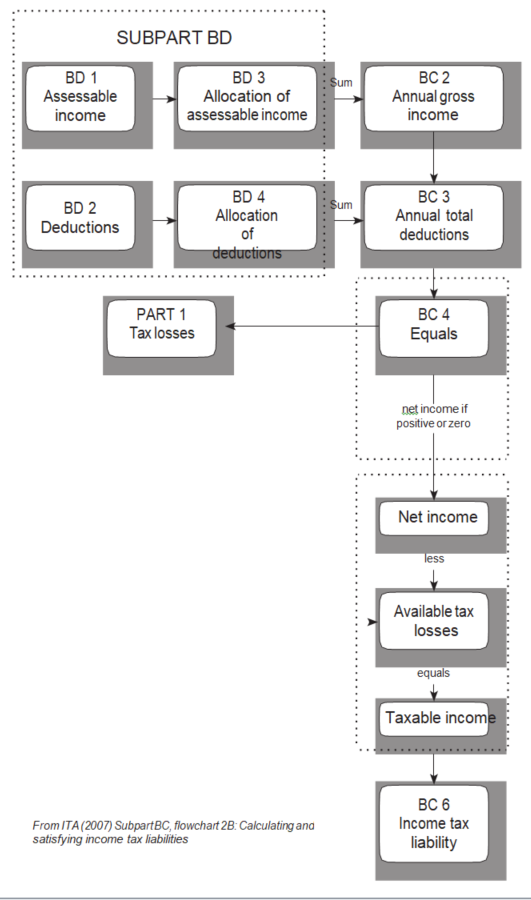Chapter 1 - New Zealand Tax Framework
New Zealand taxation is imposed by the Income Tax Act 2007 (ITA). The basis for calculating tax is summarised in the following flowchart from the Core Provisions set out in Part B of the Act. This overview provides the context for details discussed in this quick reference guide.
“It’s income tax time again...: time to gather up those receipts, get out those tax forms sharpen up that pencil and stab yourself in the aorta.”
Dave Barry
(David McAlister Barry: Pulitzer Prize-winning author and columnist)
Calculating your income tax liability:
Step 1 - Determine Assessable Income
(References are to section in Subpart BD of the ITA)

Step 2 - Determine Taxable Income and Income Tax Liability

Comments / explanation:
Allocate income and deductions to the correct tax year (referred to in the Act as “income year”).
Gross Income minus deductions equals net income if the answer is positive, and net loss if the answer is negative.
Tax losses carried forward from previous years may be set off against net income from the current year to reduce the taxable income. A net loss in the current year may be added to previous tax losses increasing the amount that may be carried forward to set off against future net income.
Multiply taxable income by the basic tax rate to calculate your tax liability. If the result is negative, the tax to pay is zero.
“Taxation according to income is the most effective instrument yet devised to obtain just contribution from those best able to bear it and to avoid placing onerous burdens upon the mass of our people.”
Franklin Roosevelt
Step 3 - Satisfying your Income Tax Liability
Any tax credits that you may have must be used to satisfy your tax liability for a tax year as far as the credits extend. If the credits exceed the tax liability, the Act sets out the order in which the credits must be used (s LA 4).
This guide clarifies the details of calculating income tax and meeting your tax liabilities. It also covers Goods and Services Tax (GST), Fringe Benefit Tax (FBT), Accident Compensation (ACC) payments, as well as tips, traps and practical advice to help you minimise the tax that you pay, while meeting your compliance requirements. It all starts with effective tax planning.
New Zealand taxation is imposed by the Income Tax Act 2007 (ITA). The basis for calculating tax is summarised in the following flowchart from the Core Provisions set out in Part B of the Act. This overview provides the context for details discussed in this quick reference guide.
Tax rates have come down in the past several years, but rates still vary for different taxpayers such as individuals, companies and trusts. There are also special rules that apply to certain taxpayers and not to others. While this is so, opportunities will exist to structure your affairs to benefit from the different rules and tax rates.
“Tax residence” and “source of income” are central to determining liability for taxation in New Zealand. Residence determines the jurisdiction and source relates to where income is earned or deemed to be earned.
Not every gain received by you or your business is taxable. The Income Tax Act only imposes tax on taxable income.
The questions of what expenditure is deductible and when, are of prime importance in determining your tax liability. For most expenditure, the question of deductibility is straight forward. However, there are exceptions. This chapter looks at what you may deduct and when.
Expenditure on capital assets cannot be deducted immediately. The value of the asset depreciates over time and the cost is spread over its useful life. Costs are there- by matched against any income that the asset generates and the tax deduction occurs each year on a more gradual basis until the asset is fully depreciated.
Entertainment expenditure must be for business purposes to be deductible and special rules exist to clarify what may be claimed for tax. The rules are slightly different for GST. There is a working party looking at simplifying the regime but in the meantime, the current rules apply.
Trading stock purchases are a regular and significant revenue expense for many businesses. However unlike many other revenue expenses, a tax deduction for trading stock is only allowed at the time the stock is sold.
This chapter distinguishes between taxable and non-taxable property transactions.
The Financial Arrangements or Accrual Rules are a detailed set of rules relating to the tax treatment of debts and debt instruments and transactions including debt related aspects.
Your business structure can have a huge impact on taxation and the legal framework under which your business operates. Here, we compare the different business structures available to you. These are discussed in greater depth in following chapters.
Companies are a popular structure for doing business because they allow a degree of protection and flexibility. Companies offer business people the advantages of limited liability and may provide a beneficial structure for tax purposes.
A partnership is formed by a contract between parties, to carry on business or commercial activities in common, with a view to making a profit.
A trust is a legal promise by a trustee or trustees to hold and administer property, sold or gifted by a settlor, for the benefit of identified beneficiaries.
Primary production in New Zealand forms a major part of our GDP. Not surprisingly there are specific tax provisions relating to this form of enterprise. Agricultural production is unique since it is the only form of production involving “natural increase”. As a result, special accounting and tax rules are required.
A number of events in the forest life cycle give rise to taxable forestry income. Clearly, this includes the net proceeds of sales, including felled timber and thinnings etc. In addition, sales or transfers of forestry or cutting rights are also taxable. The forestry regime also contains special rules for deduction of forestry expenditure.
Being a small country, much of our investment is off shore. Although this accounts for a relatively small portion of New Zealand’s tax revenue, overseas investment is governed by quite a complex regime and affects a large percentage of the population either directly or indirectly.
Provisional tax is a means of paying tax on income, that is not fully taxed at source via PAYE or other withholding payments.
In this chapter, we consider withholding tax obligations in respect of interest, dividends and royalties paid. We also look at Non- Resident Contractors Tax. Chapter 26 “Employment Responsibilities” discusses withholding tax obligations when you pay New Zealand resident contractors, including commission agents, builders etc.
Fringe benefit tax (FBT) was introduced to tax non-cash benefits provided to employees or associates of employees. These rules also apply to non-cash benefits provided to shareholder employees and their associates.
The application of GST to the majority of New Zealand business transactions is straightforward. GST can however give rise to difficult issues, especially in the area of “non standard” transactions. This would include the sale and purchase of real estate, financial services based transactions, GST on fringe benefits provided and GST adjustments for entertainment tax.
Accidents and injuries in New Zealand are covered by a publicly funded insurance scheme administered by the Accident Compensation Corporation (ACC).
Year-end tax planning is an important part of managing your tax expense. Year-end tax planning should be undertaken prior to year end. For 31 March balance date businesses, this review should be conducted in February.
Unless these matters are handled by a bookkeeper or dealt with efficiently, a considerable amount of your otherwise productive business time will be expended in complying with your basic tax obligations.
Failure to meet tax obligations may result in civil penalties, criminal penalties (discussed below) or both. Further, the penalties are not deductible for taxation purposes!
The business laws addressed in this chapter have a huge bearing on how you can and can’t do business in New Zealand. In the documentation that you keep for running your business, it is well worth noting relevant legal matters and how you plan to ensure compliance.
This section summarises key points to help you fulfil your obligations as a good employer, reduce day-to-day problems and comply with the law.
